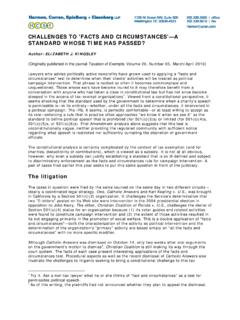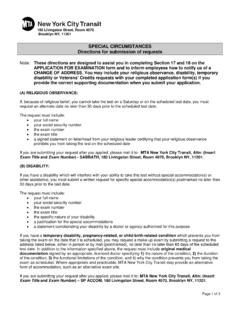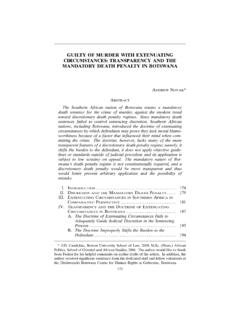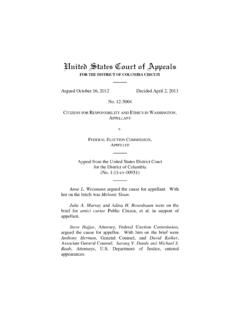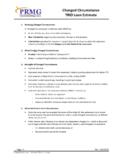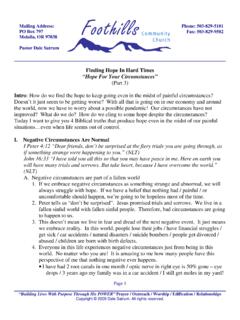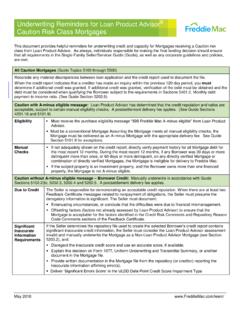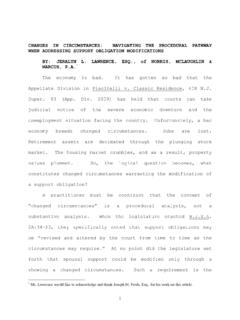Transcription of CHAPTER 12 CRITICAL CIRCUMSTANCES Table of Contents
1 CHAPTER 12. CRITICAL CIRCUMSTANCES . Table of Contents I. INTRODUCTION ..2. II. SUBMISSION OF ALLEGATION ..2. III. BASIS FOR FINDING CRITICAL CIRCUMSTANCES ..3. A. CRITICAL CIRCUMSTANCES Criteria ..3. B. Treatment of all others ..9. C. Treatment of Non-Cooperative (AFA) companies ..10. D. Treatment of NME entities ..12. IV. SEPARABILITY OF CRITICAL CIRCUMSTANCES FINDINGS FROM DUMPING. DETERMINATIONS ..13. V. COLLECTION AND VERIFICATION OF VI. PRELIMINARY A. Issuance of Findings ..14. B. Retroactive suspension of liquidation.
2 14. VII. FINAL FINDINGS ..15. A. Affirmative Final Findings ..15. B. Negative Final Findings ..15. VIII. CRITICAL CIRCUMSTANCES DETERMINATIONS BY THE ITC ..15. References: The Tariff Act of 1930, as amended (the Act). Section 732(e) - information regarding CRITICAL CIRCUMSTANCES Section 733(e) - preliminary determinations Section 735(a)(3), 735(b)(4)(A), 735(c)(3), 736(c)(4) - final determinations Department of Commerce (the Department) Regulations 19 CFR - preliminary and final determinations SAA. Section - CRITICAL CIRCUMSTANCES Section - time limits on retroactive assessments Antidumping Agreement Article - retroactive duties Policy Bulletin Change in Policy Regarding Timing of Issuance Of CRITICAL CIRCUMSTANCES Determinations; Policy Bulletin , issued October 8, 1998 (63 FR 55364 (Oct 15, 1998).)
3 Legislative History 1994 Uruguay Round Agreements Act; H. Rep. 103-826 at 50-51; S. Rep. 103-412 at 38-39. 1987 Omnibus Tariff Act; S. Rep. 100-71 at 91-94. 1988 Omnibus Trade and Competitiveness Act; H. Rep. 100-576 at 610-612. Antidumping Manual CHAPTER 12. I. Introduction In investigations, an importer of a product under investigation becomes liable for antidumping duties at the time the product enters the United States for consumption. If the merchandise is subject to suspension of liquidation in a proceeding, when an entry takes place, the importer must post a bond or a cash deposit of estimated dumping duties with CBP.
4 Normally, suspension of liquidation is effective the date that an affirmative preliminary determination is published in the Federal Register. An importer of a product under investigation becomes liable for potential antidumping duties on entries made after this date. Usually, an importer can import subject merchandise prior to the preliminary determination without being liable for dumping duties. However, in anticipation of high preliminary dumping duties, the importer could deliberately import and stockpile large quantities of a product under investigation prior to the Department ordering suspension of liquidation in order to avoid paying antidumping duties later.
5 In order to counter this type of stockpiling, section 733(e) of the Act provides for 90-day retroactive suspension of liquidation where certain CRITICAL CIRCUMSTANCES . are present. Whether CRITICAL CIRCUMSTANCES are found and whether duties on these pre-preliminary entries will ever be collected depends on affirmative findings by both the Department and the ITC. To determine CRITICAL CIRCUMSTANCES , the Department must determine that: 1) there is a history of dumping and material injury by reason of dumped imports in the United States or elsewhere of the subject merchandise; or 2) the importer knew or should have known that the exporter was selling the merchandise at less than fair value and that there was likely to be material injury by reason of such sales; and 3) there have been massive imports of the subject merchandise over a relatively short period of time.
6 Further, for action to be taken, the ITC must determine that the imports seriously undermine the remedial effectiveness of the antidumping duty order. See Section 733(e) of the Act. II. Submission of Allegation Generally petitioner may allege CRITICAL CIRCUMSTANCES in the petition, or by amendment to the petition at any time. However, an allegation may be no later than 21 days before the date of the final determination. See section (b) of the Department's regulations and CHAPTER 2 of the manual. In cases where the surge of imports is expected to occur after the filing of the petition, the petitioner clearly cannot provide information in the petition to demonstrate a surge.
7 However, where the petitioner additionally alleges that producers, exporters or importers had advance knowledge that a petition would be filed, it is appropriate to evaluate the evidence provided in the petition for sufficiency. For example, in Steel Plate from the Czech Republic, the petitioners alleged that there was sufficient pre-filing notice of the antidumping petitions. See Initiation of Antidumping Investigations: Certain Cut-to-Length Carbon-Quality Steel Plate from 2. AD Manual CHAPTER 12. the Czech Republic, France, India, Indonesia, Italy, Japan, the Republic of Korea, and the Former Yugoslav Republic of Macedonia, 64 FR 12959, 12966 (March 16, 1999) (Steel Plate from the Czech Republic).
8 III. Basis For Finding CRITICAL CIRCUMSTANCES A. CRITICAL CIRCUMSTANCES Criteria 1. There is a history of dumping and material injury To determine whether there is a history of dumping, we examine recent antidumping duty cases of the product under investigation in the United States or elsewhere. a. Generally A history of injurious dumping typically exists when the United States has had an antidumping duty order on the product, or another country has a current antidumping duty order on the product. See, , Notice of Preliminary Determination of Sales at Less Than Fair Value, Postponement of Final Determination, and Affirmative Preliminary Determination of CRITICAL CIRCUMSTANCES in Part: Certain Lined Paper Products From India, 71 FR 19706, 19712 (April 17, 2006) (Lined Paper Products From India).
9 In determining whether a history of dumping and material injury exists, the Department generally examines current or previous antidumping duty orders in the United States on the subject merchandise from the country under investigation. Id. The Department also considers current orders in any other country that cover the subject merchandise from the country under investigation. Id. The Department will normally not consider the initiation of a case, or a preliminary or final determination of sales at LTFV in the absence of an affirmative finding of material injury by the ITC, as indicative of a history sufficient to satisfy this criterion.
10 See Notice of Preliminary Determination of Sales at Less Than Fair Value, Postponement of Final Determination, and Affirmative Preliminary Determinations of CRITICAL CIRCUMSTANCES in Part: Prestressed Concrete Steel Wire Strand from Mexico, 68 FR 42378, 42384 (July 17, 2003); see also Partial Affirmative Preliminary Determination of CRITICAL CIRCUMSTANCES : Chlorinated Isocyanurates from the People's Republic of China, 70 FR 18362, 18364, fn. 5, (April 11, 2005) (Chlorinated Isocyanurates from the PRC). (unchanged in Final Determination, 70 FR 24502 (May 10, 2005)) (the Department refrained from regarding the European Union's initiation of an antidumping investigation of isocyanurates as a factor in determining the existence of injurious dumping).









